Learn how to make almond milk yogurt, a delicious way to get a dose of probiotics. It’s a healthy dairy-free probiotic alternative for smoothies, breakfasts, and desserts.
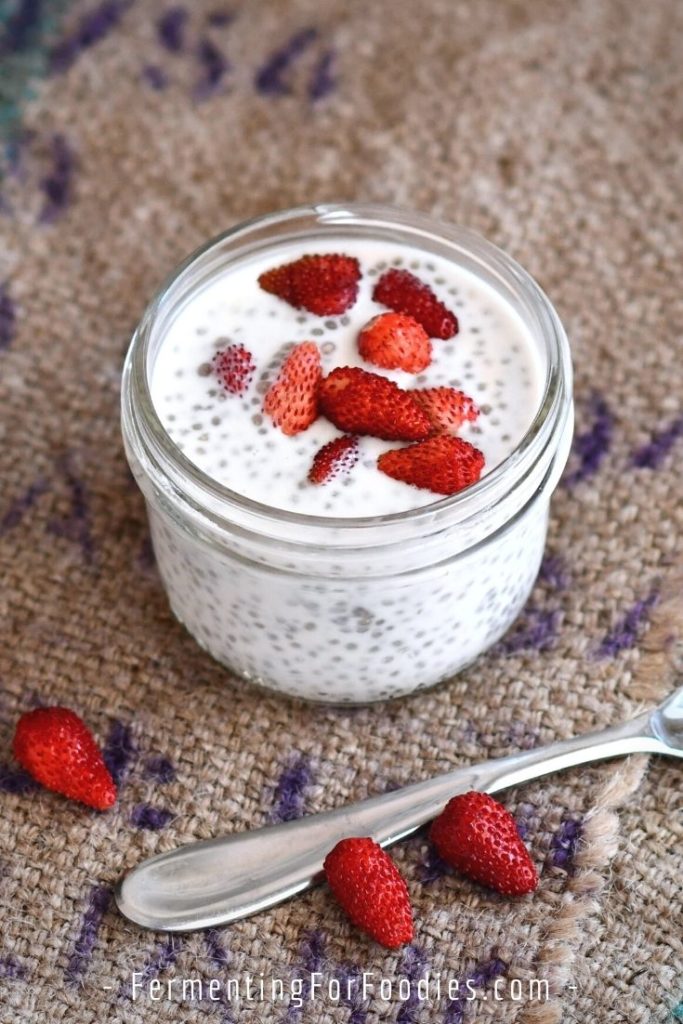
Why make almond milk yogurt?
I make a lot of dairy-free yogurts. This is in part because there are a few people in my family with dairy allergies. However, I also love the flavor and culinary usefulness of homemade almond milk yogurt.
Here are a few reasons why I make milk yogurt:
- I love to make almond milk. However, it only lasts 2-3 days in the fridge. Turning it into yogurt means that it will last for a week or two!
- While we’re not a completely vegan family, we do try to limit the amount of dairy we consume. Almond milk yogurt is the mildest and naturally sweet-tasting dairy-free yogurt option.
- I love it as a healthy dessert topping. I just add a bit of vanilla or cinnamon, and it’s perfect for serving with apple cobbler or pumpkin pie.
- My kids love a glass full of homemade almond milk yogurt with a few wild strawberries in as an afterschool snack!
- It’s perfect for pouring over my morning bowl of nutola.
Other Dairy-Free Yogurt Options
There are quite a few dairy-free yogurt options. And I make most of them pretty regularly. The trick is to buy a good dairy-free culture.
Almond milk yogurt is one of my favorites. I typically enjoy it as a yogurt drink rather than a thickened yogurt.
Here are a few other types of dairy-free yogurts that you can make at home:
- Coconut cream yogurt: Naturally thick and sweet, coconut milk yogurt is delicious dolloped into soups or curries. It’s also perfect for smoothies and desserts.
- Soy milk yogurt: Soy milk makes the most “dairy-like” yogurt. The flavor is mild, and it naturally thickens. However, it can be hard to find preservative-free soy milk in the store.
- Cashew yogurt: Thick cashew cream can be cultured, giving it a cheese-like flavor. It’s probably the best dairy-free cream cheese substitute.
Almond Milk Yogurt Thickeners
Homemade almond milk yogurt won’t naturally thicken like yogurt. So I usually enjoy my almond milk yogurt as a probiotic beverage. However, it is possible to add thickeners for a more yogurt-like consistency.
Here are a few options for thickening almond milk yogurt:
- Chia seeds: Chia seeds are my favorite thickener. Perfect for a prebiotic boost! They are easy to use and add fiber, protein, and omega-3 fatty acids. The only trick is they don’t make a really thick yogurt. More of a bubble tea-like drink.
- To add chia seeds, stir 1 Tbsp of chia seeds or ground chia directly into 1 cup of yogurt. Don’t scale up the recipe or the chia seeds will clump at the bottom of the container. Just make several 1-cup jars of chia-thickened yogurt.
- Tapioca starch: Tapioca isn’t my favorite thickener, as it tends to separate. It also doesn’t add much to the flavor of the yogurt.
- Dissolve 4 Tbsp of tapioca starch in a small amount of water before adding to 4 cups of warm almond milk.
- Agar-agar powder: I haven’t personally tried agar, but I have a friend who loves it.
- Whisk 1 tsp agar-agar powder directly into the warm milk.
- Xantham gum: While xantham gum can be used to thicken almond milk, it also has a tendency to clump and separate.
- Whisk 1 tsp xantham gum into the milk.
- Pectin: Pectin will set a very firm yogurt. It’s probably the best option for a thick “Greek yogurt”.
- Use Pomona’s Universal Pectin and follow the directions on the package. (I love Pomona’s for all sorts of desserts).
How To Make Almond Milk Yogurt
Homemade almond milk yogurt is a delicious and dairy-free probiotic drink. See the section above for five ways to thicken almond milk yogurt.
- Prep Time: 5 minutes
- Cook Time: 4 hours
- Total Time: 4 hours 5 minutes
- Yield: 4 cups 1x
- Category: Yogurt
- Method: Fermented
- Cuisine: Healthy
- Diet: Vegan
Ingredients
- 4 cups of nut milk (see notes)
- 4 Tbsp of yogurt with live culture (or a pack of vegan yogurt culture)
Instructions
- Slowly heat the almond milk to 110 F (40 C), whisking occasionally to keep the milk from scalding on the bottom of the pot. At this point, you may want to mix in a thickener. See the section above for more details on how to thicken your yogurt.
- Pour the milk into the culturing containers and stir culture into the milk. Maintain at around 105F (40 C) for at least 4 hours. If you like a sour yogurt then you can leave it for up to 24 hours.
- Store in the fridge and use within 2 weeks, or freeze for longer-term storage. I also recommend freezing 1/4 cup of yogurt to use as a culture for your next batch of yogurt. It’s the best way to maintain an active culture.
Notes
- You cannot make yogurt with nut milk that has preservatives. The goal of preservatives is to prevent bacterial growth. So either use homemade almond milk or nut milk labeled as Preservative Free. Even if it’s organic, if it doesn’t say Preservative Free, then it could contain natural preservatives.
- This recipe works for all sorts of nut milk, including hazelnut milk or hemp milk. It also work with oat milk!
- You can use a yogurt maker to make several small jars of yogurt. Personally, I use a folding fermentation box so that I can make a large volume of yogurt at once. However, there are ways to make yogurt without a yogurt maker.
- To make chocolate almond milk yogurt, add 2 Tbsp of cocoa powder to the hot almond milk before adding the culture. Stir in your favorite sweetener after culturing, or eat it with sliced bananas for a naturally sweet treat.
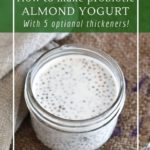
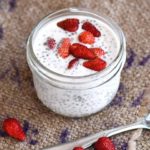
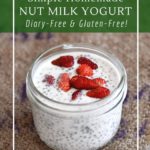
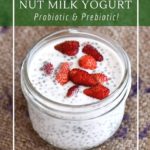
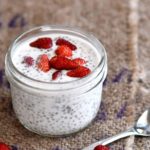
With the chia seeds, do you need to grind them or do you leave them whole? Thanks for the recipe! I’m looking forward to trying.
It depends on what you want… Ground chia will be smoother, but I actually like the little chia seed balls. Just mix it several times over the first day because the chia will sink and solidify on the bottom of your container.
Never made almond milk yogurt. I’ll give it a try
Thank you for these tips! I love homemade yogurt but have just been diagnosed with a dairy allergy, so I am new to this realm of cooking. I was wondering if adding in thickeners like the ones you had suggested will prevent the thickened vegan yogurt from being used as a starter culture for future batches? If so, is it possible to add the thickeners in AFTER the fermentation has occurred? I would like to maintain my own culture, if possible. Thank you!
I think you can still culture it with the added thickeners. I use various store-bought yogurts and they always worked (despite various thickeners.) Chia seeds can be added after fermentation, but all the other thickeners work best when added to warm almond milk, so you will need to add them before fermenting.
Hi!
Can I use probiotics instead of starter?
Thanks a lot!
This is a great alternative to store bought yogurt with all the packaging!
Especially, if you make your own almond milk! Enjoy!
You are blowing my mind with your dairy-free yogurts. I’ve had really mixed success with other recipes when making almond milk and coconut milk yogurts. Your tips about preservatives and the anti-microbial nature of coconut oil (so no reculturing) is SO helpful. Always lots to learn with fermenting and I really appreciate the help.
So glad that my recipes worked out for you! They’re all recipes I make regularly, so they’re well-tested. 🙂 Cheers, Emillie